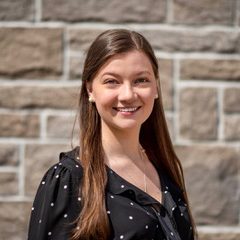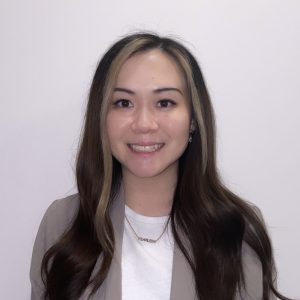
 Written by: Kaitlyn Chuong, CBR Communications & Programs Coordinator & Alexandra Witt, PhD Candidate, Pryzdial Lab
Written by: Kaitlyn Chuong, CBR Communications & Programs Coordinator & Alexandra Witt, PhD Candidate, Pryzdial Lab
February 11 is recognized by the United Nations (UN) as the International Day of Women and Girls in Science, which aims to spotlight the contributions of women in science, technology, and innovation. This day is a reminder that women and girls play a critical role in STEM communities and an opportunity to promote full and equal access to science around the world.
This year, we had the pleasure of chatting with several leaders in the CBR community to learn more about their research, share their stories, and celebrate all that they do. The CBR is proud to have dedicated, passionate, and driven female leaders that students, trainees, and staff can learn from. Read more about them below!

L-R: Dr. Agnes Lee, Dr. Hayley Merkeley, Dr. Hélène Côté, Dr. Karen Cheung, Dr. Kelly Brown, Dr. Natalie Strynadka
What is the focus of your work?
Dr. Agnes Lee: Treatment of cancer-associated thrombosis has been the main focus of my research for the past 20 years. I am a clinical trialist and a hematologist. As a result of my work, I’ve also been involved in developing clinical practice guidelines and participating in data monitoring committees for clinical trials.
Dr. Hayley Merkeley: My research is focused on the clinical care of patients with red blood cell disorders like sickle cell anemia and thalassemia, including the efficacy of new treatments and improvement of existing care.
Dr. Hélène Côté: I have two main research topics: 1) Understanding why people living with HIV, and more particularly women living with HIV, experience aging-associated diseases many years earlier than men living with HIV or women who are HIV-negative. 2) Understanding the effects of in utero exposure to HIV medications, and why children born to mothers with HIV have more neurodevelopmental and neuropsychiatric diseases.
Dr. Karen Cheung: Our research group uses nano- and microfabrication techniques to develop technologies for life sciences and medicine. We take advantage of phenomena at the microscale that allow us to control the microenvironment around microtissues, and create representative models of organs on chips. Our group has ongoing projects in tissue engineering, silicon photonic biosensors, inkjet dispensing of single cells for sequencing and proteomics, implantable microelectrode neural interfaces, and development of microfluidic organs-on-chip.
Dr. Kelly Brown: Research in my laboratory is done in partnership with clinicians, patients, and advocates towards a common goal of providing the best evidence-based care for children with vasculitis and other rheumatic diseases. My team uses a bedside-to-bench approach to discover and validate quantifiable biomarkers that can aid with diagnosis and treatment decisions for affected children. Our initiative on childhood-onset vasculitis was supported by a multi-year CIHR grant that enabled the largest collection of data and samples from (> 400) children with vasculitis – which is remarkable given that there are only 1-2 new diagnosed cases per year in BC!
Dr. Natalie Strynadka: Our lab uses an array of molecular biology, biochemical, and biophysical techniques such as x-ray crystallography and cryo-electron microscopy to determine atomic structures of membrane protein complexes that represent logical targets for structure-guided anti-microbial and vaccine discovery. We use this atomic information as precise blueprints to design new therapeutics to combat drug resistant infections.
"I love doing research and pursuing new knowledge. Ever since I was young I have wanted to make new discoveries. I also love applying this new knowledge to solve problems; this combination has brought me to biomedical engineering." - Dr. Cheung
"I think I naturally gravitate towards the arts, but what I love about medicine is translating science into patient experiences. Especially in meaningful ways such as reducing the amount of pain they experience or helping them grow their families. My undergraduate background is in Hispanic studies and psychology, and I want to highlight that there are many paths to becoming a doctor, which enriches our profession." - Dr. Merkeley
"Growing up, I spent large parts of each summer roaming and helping out on my grandparent’s wheat farm in rural Alberta. That freedom to explore and the wisdom of my grandmother (an unofficial but truly impressive botanist, conservationist and artist…) laid an early foundation for loving nature and the scientific underpinnings therein." - Dr. Strynadka
"Structural biology has a long history of amazing, trailblazing women in the field. This includes Nobel Prize laureate Dorothy Hodgkin, the first to characterize insulin and penicillin amongst other important works. My PhD supervisor trained with her at Oxford, and I was fortunate enough to meet and speak with her as a graduate student on several occasions. These interactions had a lasting impact not only on my love of atomic level science and process, but the faith that one can nurture both a family (Professor Hodgkin had 3 children) and a scientific career as a woman." - Dr. Strynadka
"Unfortunately not. There were very few women in the Biochemistry department back then. I think however because of that, I make a point of supporting young women in science and find pleasure in supervising the new generation of scientists." - Dr. Côté
"I first began thinking about patient-partnered research when I was tasked with the analysis of patient samples as an undergraduate thesis student. I’ve been thinking about and teaching myself to be a translational researcher ever since. It has been especially meaningful and rewarding to become the first PhD scientist hired to the UBC (clinical) Division of Pediatric Rheumatology and Scientific Lead of one of only a couple of labs in Canada where researchers can get specialized training in patient-oriented research on childhood-onset rheumatic diseases." - Dr. Brown
"The CLOT trial, published in NEJM in 2003, demonstrated superiority of low molecular weight heparin (LMWH) over warfarin for treatment of cancer-associated thrombosis. This helped to change clinical practice worldwide and established LMWH as the first line therapy for this indication. To-date, LMWH remains one of the drugs of choice in treating patients with cancer and thrombosis." - Dr. Lee
"Establishing two large cohorts of people living with HIV. One of women (cis and trans) and girls, and the other, pregnant women and their infants. And now, doing community-based research, and employing community research associates (women living with HIV who have been trained in research)." - Dr. Côté
"Sometimes it's hard to look around and know that women tend to have lower self-confidence and feel less self-efficacy about our abilities in science and engineering. It's natural to internally expend mental energy dealing with microaggressions. Finding a way to speak up and intervene, unprompted, when we observe these situations happening to others, can help mitigate these negative experiences on our colleagues, and help sustain more women in STEM." - Dr. Cheung
"Trust your instincts and training and be confident. Our male colleagues often feel inadequacy the same way we do but have been conditioned by society to present more confidently. At the same time, it is always important to remain humble and learn from our colleagues and patients. The more experience you gain, the more comfortable you will be learning to strike this balance." - Dr. Merkeley
"Balancing the priorities of work and home is always a challenge. Reality is that the ‘balance’ is not a static space, where we stand squarely on our feet; but rather it is a scale that tips 360 degrees constantly and we do our best to not fall off! Some days I might not be the best mother and other days I might fall short of being the best doctor or the best researcher, but I try my best and remind myself that, sometimes, I did do a fantastic job! My biggest motivation is my kids – how can I make the world a better place for them?" - Dr. Lee
"By the time I reached school age, I was already aware of, perplexed about, annoyed by, and wholly uninterested in society’s expectations of who I, as a girl, was - and was not - supposed to be. Being true to myself in the face of deep-rooted societal gender stereotypes has been a challenge, but one that is lessened by the inspiration that comes from others (my students, colleagues, community) that are taking steps to educate themselves about EDI, understand the experiences of others, and enact positive change towards a more equitable workplace and society." - Dr. Brown
Thank you to Drs. Brown, Cheung, Côté, Lee, Merkeley and Strynadka for sharing their stories with us! We are proud to have you as part of our CBR community, and can’t wait to see all that you will continue to accomplish in the future.
To learn more about International Day of Women and Girls in Science, please visit the UN website.


